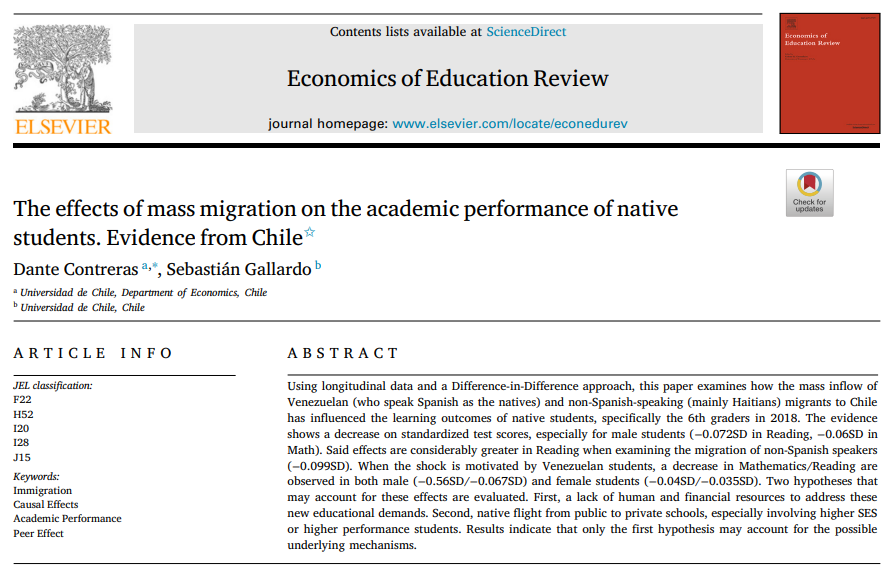The Nuz
Nalgas de acero
- Registrado
- 2009/01/08
- Mensajes
- 27.949
- Sexo

Que lo hagan, las amenazas no sirven de nada. Si queda la cagá sea de una pero ojalá sin muertes, es la unica forma que despabilen todos estos hijos de puta.
Follow along with the video below to see how to install our site as a web app on your home screen.

Nota: This feature currently requires accessing the site using the built-in Safari browser.



Abstract
Using longitudinal data and a Difference-in-Difference approach, this paper examines how the mass inflow of Venezuelan (who speak Spanish as the natives) and non-Spanish-speaking (mainly Haitians) migrants to Chile has influenced the learning outcomes of native students, specifically the 6th graders in 2018. The evidence shows a decrease on standardized test scores, especially for male students (−0.072SD in Reading, −0.06SD in Math). Said effects are considerably greater in Reading when examining the migration of non-Spanish speakers (−0.099SD). When the shock is motivated by Venezuelan students, a decrease in Mathematics/Reading are observed in both male (−0.56SD/−0.067SD) and female students (−0.04SD/−0.035SD). Two hypotheses that may account for these effects are evaluated. First, a lack of human and financial resources to address these new educational demands. Second, native flight from public to private schools, especially involving higher SES or higher performance students. Results indicate that only the first hypothesis may account for the possible underlying mechanisms.
Introduction
Over the last decades, migration has become one of the most relevant topics worldwide. We have seen a heated debate on the human rights of immigrants, the economic consequences of immigration, and public policies related to immigrants and their relationships with natives. In this context, the Latin America and the Caribbean (LAC) plays a major role in the world’s migratory flows, as nearly 40 million migrants came from this region in 2017 (United Nations, 2017). Even though the favorite destination of LAC emigrants is North America, intra-regional migration emerges as the second preference, with 1 out of 6 migrants moving to a LAC country (Idem).
In this context, Chile has received one of the largest migrant flows over the last years. Between 2011 and 2018, migrant population increased nearly five-fold relative to the total population, jumping from 1.4% to 6.6%.1 Since 2015, migratory flows to Chile have been strongly determined by foreigners coming from Venezuela and Haiti. This migration was motivated by political and economic difficulties in their countries of origin. Nowadays, these groups constitute the first and third largest foreign communities in the country. As a result, Chile provides an interesting opportunity for empirically examining the consequences of a rapid mass migration phenomenon.
The empirical literature that has examined the effects of migration has typically focused on the labor market outcomes of native workers,2 but there also exists a growing literature focused on educational outcomes, specifically on the academic performance of native-born students. This literature has reported mixed results. For instance, Diette and Uwaifo Oyelere (2014) explore the peer effects of Limited English students on the Reading and Math grades of native-born school students, differentially by gender and race. Using 1998–2006 administrative data of 4th to 8th grade students from North Carolina and a school-by-year fixed effect approach, the authors find zero effect on native female students, both white and black. However, they also report a modest negative effect on males, particularly on black males’ scores in both subjects and on white males’ math scores. In a previous paper, using the same data and similar specifications, these authors had provided evidence of heterogeneous effects on native-born students (as reflected by their Math and Reading test scores). Positive effects are found in the bottom and middle parts of the performance distribution, while small negative effects are found at the top (Diette & Uwaifo Oyelere, 2012).
In another study, Conger (2015), using administrative records from the Florida Department of Education, evaluates the effects of different shares of immigrant English language learners (ELL) and non-English language learners (non-ELL)3 on four cohorts of 9th graders attending Florida public high schools between 2000 and 2004. Using fixed effects by school and cohort, results indicate that immigrant peers have no effect on their classmates’ academic achievement.4
In contrast, Jensen and Rasmussen (2011), using matched administrative records and PISA results of 9th graders from Denmark in 2000, found a negative effect of immigrant concentration in schools on both Reading and Math. However, the authors acknowledge that these results are only robust with an IV approach for Math.
Bossavie (2018), in a longitudinal study in the Netherlands, examines the effect of migrant concentration on the academic performance of native-born students using a panel of primary schools observed in grade 2, 4, 6, and 8 every two years. To estimate this effect, the author considers the duration of stay of immigrant classmates, with cohort-by-cohort variation in immigrant concentration in schools having no significant effects overall, but a small negative one on Language scores for those who have spent less than 4 years in the country.
As for the literature on refugee migrants, Van Der Werf (2021) studies how the arrival of refugees from Indochina toward the end of the Vietnam War in 1975 affected the academic performance of native-born students in the USA. Using novel data from the U.S. National Archives that contain refugees’ first county of destination, the author finds a null effect or small positive effects that may have been due to the positive selection of refugees (more educated individuals) and government benefits.
Morales (2021), using more recent individual-level administrative data of students in grades 3 through 8 in a district in Georgia between 2008 and 2017, finds a positive effect of refugee concentration on the Mathematics scores of non-refugee students, while also finding evidence for non-linear on the English Language Arts (ELA) test. Despite these findings, the author also found that refugees have significantly lower test scores. Evidence shows that this may be due to changes in classroom resources and access to academic support programs.
Tumen (2021) analyzes the impact of the arrival of Syrian refugees on the PISA scores of native-born adolescents in Turkey. Using the IV-Diff-in-Diff specification, the author evaluates the magnitude of the job market mechanism whereby the arrival of migrants who occupy positions in the lower segment increases competition in the low-qualification sector and provides additional incentives for natives to improve their educational outcomes. This mechanism is found to have positive effects on native outcomes, while the educational experience mechanism is found to have negative effects as a result of the interaction between refugees and natives.
Figlio and Özek (2019), using administrative schooling and birth records, examine how Haitian refugees to Florida after the 2010 earthquake in Haiti influenced the educational outcomes of 3th to 10th grade incumbent students in public schools. Adopting different specifications to address the non-random sorting of refugees within the Florida school system, they found very modest positive effects on the academic performance of native students (particularly in Reading) the year of the earthquake and two years later.
In another study, Özek (2020), using student-level administrative data from a district in Florida, examines the effects of the arrival of internal migrants from Puerto Rico to schools after Hurricane Maria. The author finds significant adverse effects on student test scores, disciplinary problems, and student mobility, especially for high-skill natives. Evidence suggests that this may be a result of compensatory resource allocation within schools.
Finally, Padilla-Romo and Peluffo (2020) analyzes the effect of migration by focusing on the prior exposure of migrant peers to violence. Using individual-level administrative data from Mexico, they examine how incumbent students in relatively safe municipalities are affected by the arrival of migrant peers who were exposed to drug-related violence in their municipalities of origin. The authors found a negative effect on composite test scores (math and reading), more pronounced among girls and high-achieving students.
This study aims to identify the effect of recent mass migratory influxes on the academic performance of native-born Chilean students. To do so, we take advantage of the quasi-experimental situation generated by the migratory shocks from Venezuela, who speak Spanish which is the same language as the Chilean students, and Haiti, who do not speaks Spanish,5 between 2016 and 2018. Using census and longitudinal data from the SIMCE test6 provided by the Education Quality Agency and the General Student Information System, provided by the Ministry of Education’s, we applied a Difference-in-Difference strategy on the change in SIMCE scores between 4th and 6th grade. Native students whose schools received migrants from Venezuela, Haiti, or other non-Spanish-speaking countries in 2018, after having none in 2016, were the treatment group, while those who had no peers from these countries during this period were the control group. Both groups were highly balanced in terms of their observable characteristics using a nearest neighbor matching strategy with no replacement. In addition, we employed the same strategy to evaluate the effect separately, that is, when the shock affecting a school was due to Venezuelan students only or when it was exclusively produced by non-Spanish-Speaking students, largely driven by influxes of Haitian peers.7 Results indicate that the shock motivated by the arrival of migrant students between 2016 and 2018 caused a decrease on the SIMCE Reading/Math scores of male native-born students between 4th and 6th grade (−0.072SD/−0.06SD). This effect appears to be greater in Reading when the shock is due to influxes of migrants from non-Spanish-speaking countries (−0.099SD). In mathematics/reading, both male and female students exposed to the shock of Venezuelan migrants performed more poorly between 4th and 6th grade compared to the controls (−0.056SD/−0.067SD for boys, −0.04SD/−0.035SD for girls). Results suggest that there are insufficient human and financial resources to address these new educational demands in the region. Indeed, it can be observed that the student/teacher ratio increased due to the shock, which is consistent with the idea that limited resources are the mechanism behind the results obtained. The Chilean educational system allocates resources to schools according to student enrollment, but does not grant any additional resources to those that serve immigrant students.
Additionally, we evaluated whether there is evidence of native flight –of students from higher socioeconomic status backgrounds or better performing students prior to the shock– as a result of the foreign immigrant shock. This enabled us to determine whether the decrease on standardized test found for native students could be explained by a decrease in the peer effect that students with more resources –in terms of economic or academic skill– generate in the classroom. Results show some evidence for native flight8 as a response to the migratory shock, but is not motivated by those with higher socioeconomic status or higher academic performance.
The results are robust to a variety of specifications. In any case, they are not representative of the effect on the entire educational system and only refer to the effect on the 6th grade cohort in 2018. The foregoing, due to the fact that it is possible to control for the non-random sorting of immigrant students through of the different courses within the school only partially.
This study contributes to the literature on the peer effect of migrant students at the school-grade level on various educational outcomes. First, to the best of our knowledge, this is one of the first studies to show evidence about immigrant peer effect in LAC. Second, by taking advantage of the quasi-experimental situation generated by the migratory influxes of recent years, we provide causal evidence of the short-term classroom effects of migrant student flows, considering that native-born students had no foreign classmates9 beforehand. Third, we provide an early examination of the mechanisms that may be influencing outcomes, such as greater restrictions on school resources due to the higher student/teacher ratio and the native flight of higher-SES or higher achieving native-born students. Lastly, the quality of the longitudinal and administrative census data in this study supports the accuracy of the results found.
After this introduction, Section 2 provides a brief description of the chilean school system and some statistics to contextualize the recent situation of migration within the Chilean educational system. Then, in Section 3, we explain the data and the strategy to be used to evaluate the effect of recent mass migratory inflows on the academic performance of native Chilean students, along with their possible underlying mechanisms. The fourth section shows our main findings and the robustness exercises, while the fifth and last section contains our conclusions.
Section snippets
The Chilean school system
The Chilean educational system underwent significant modifications in the 1980s as a result of reforms implemented by the military government (which led the country in 1973–1990). The reforms included decentralizing the administration of educational establishments by transferring the administration of public schools from the Ministry of Education to Municipal Authorities.10
The reforms
Data
To study the effects of mass immigration on the academic performance of native-born students, we will use SIMCE panel data to follow the same students in 2nd, 4th, and 6th grade in 2014, 2016, and 2018 respectively. This database derives from a census-type measurement performed annually by the Education Quality Agency at several levels of the primary and secondary system. It comprises individual sociodemographic variables such as parents’ educational level and the income level of students’
The effect of immigration on academic performance
The top panel of Table 4 shows the results of the DD estimation of Eq. (1). The first column indicates that native students subjected to a shock caused by the inflow of migrant students in their school-grade level between 2016 and 2018 performed more poorly on the SIMCE Reading test (−0.051SD) than native students who received no foreign students in their school and grade. Columns 2 and 3 disaggregate the results of the first column, but restricted to boys and girls respectively. The effect on
Conclusions
This paper examines the effects of a mass immigrant influx on the educational outcomes of native students, based on the large increase in Venezuelan and Haitian migration to Chile that started in 2016 and peaked in 2018. In general, negative effects of these migratory inflows are observed. The mass arrival of immigrants, together with the relatively small size of Chile’s population, made it possible to detect these effects.
To do so, the paper uses longitudinal data from administrative databases
CRediT authorship contribution statement
Dante Contreras: Preparation of the paper, Data analysis, Econometric models, Writing the document. Sebastián Gallardo: Preparation of the paper, Data analysis, Econometric models, Writing the document.
Acknowledgment
All the authors have approved the final version of the research article.

Chiiiiii y aonde dejai a los fucking masisis!!!Esa pregunta creo que es super difícil de responder, ya que hay muchos más veneCOS que congolombianos.
Personalmente creo que ambos son escorias qls y los dominicanos unos peldaños más abajo.

Dame un host y lo subo de inmediato.A proposito de las lacras caribeñas. Algún cilantrito que tenga acceso y pueda compartir el PDF de este paper donde se indica la incidencia negativa de la llegada de extranjeros, venezolanos y haitianos, en el rendimiento académico de los estudiantes chilenos. Será agradecida por la comunidad antroniana.
https://www.sciencedirect.com/science/article/abs/pii/S0272775722000875?via=ihub


Sirve?Dame un host y lo subo de inmediato.



los masisis en chile dejan menos cagadas hasta el momento ( no gangas, no tanto ataque con machete, sólo sus incivilidades de primates )Chiiiiii y aonde dejai a los fucking masisis!!!




A proposito de las lacras caribeñas. Algún cilantrito que tenga acceso y pueda compartir el PDF de este paper donde se indica la incidencia negativa de la llegada de extranjeros, venezolanos y haitianos, en el rendimiento académico de los estudiantes chilenos. Será agradecida por la comunidad antroniana.
https://www.sciencedirect.com/science/article/abs/pii/S0272775722000875?via=ihub

Descarguen pronto porque el enlace caduca en 7 días.Recuerden cuando quemaron Viña y gritaban "Liberen a la Estrella"
Post automatically merged:
Sirve?

Zippyshare
Zippyshare is a popular file hosting and sharing platform that allows users to upload, store, and share files with others.www.zippyshare.day



Mi ranking (1 el más callampero):Esa pregunta creo que es super difícil de responder, ya que hay muchos más veneCOS que congolombianos.
Personalmente creo que ambos son escorias qls y los dominicanos unos peldaños más abajo.

ensartao en el pico del lorYO ÑAKSONBoric debe morir


Que algún antronero se raje con la versión traducida por favorDescarguen pronto porque el enlace caduca en 7 días.
Quedo atento a cualquier antroniano que necesite algún paper de acceso restringido
WeTransfer - Send Large Files & Share Photos Online - Up to 2GB Free
WeTransfer is the simplest way to send your files around the worldwe.tl


si pero = al q incluirlos en el pack negroide-caribeñolos masisis en chile dejan menos cagadas hasta el momento ( no gangas, no tanto ataque con machete, sólo sus incivilidades de primates )

obvio , tienen el potencial de ser tan mierdas que hasta las de república dominicana los encuentras nefastossi pero = al q incluirlos en el pack negroide-caribeño

los chilenos no van a despertar, la última vez q despertaron, la izquierda se apoderó del movimiento y acabó en el poder.Este es el tipo de cosas que desatarán represalias hacia el lumpen latinoamericano. Pronto van a cumplir con lo que dicen y cometerán el error de echarse una comisaría entera.
En ese momento o similar los chilenos vamos a despertar. No va a quedar otra.

Comentarios culiaosya tienen claro los venecos que aca ya no los quieren



Descarguen pronto porque el enlace caduca en 7 días.
Quedo atento a cualquier antroniano que necesite algún paper de acceso restringido
WeTransfer - Send Large Files & Share Photos Online - Up to 2GB Free
WeTransfer is the simplest way to send your files around the worldwe.tl

Para lo bertos que no sabemos leer. Que dice? Usted es sociólogo, cuenteDescarguen pronto porque el enlace caduca en 7 días.
Quedo atento a cualquier antroniano que necesite algún paper de acceso restringido
WeTransfer - Send Large Files & Share Photos Online - Up to 2GB Free
WeTransfer is the simplest way to send your files around the worldwe.tl


por eso no espero nada de esta raza culia, Chile con todos los arbolitos y los pendejos sub 30 años de verdad tiene algo mejor que los putos monombianos o venekonglanos??Lo que sorprende es el apoyo de chilenos que todavía defienden a estás mierdas


